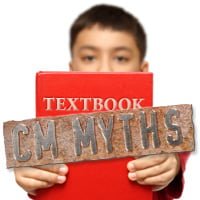60-day returns • free shipping on USA orders $129+


As we continue our fun series on CM Myths, I hope these posts are serving to encourage and, hopefully, educate you a little too. This week we will take a look at the idea that Charlotte Mason never used any textbooks.
Usually the comments go something like this:
“I like the idea of using living math books, because after all, Charlotte never used a textbook. But I’m not certain that these stories and real-life experiences are giving my child enough practice to master the basic math facts.”
“Since Charlotte didn’t use a textbook for math, did she require her students to learn the multiplication tables?”
“Charlotte said not to use textbooks, so I’m looking for a living book that will teach the parts of speech for English grammar.”
The Facts
From the research I’ve done, it looks like Charlotte used what we would consider to be a textbook for a couple of subjects: most notably, math and English grammar. I also found one for upper level science.
I know. I was surprised too.
Yet if you peruse her booklists for various Terms, you will find she recommended the titles below. These books are not stories. They present the information in a succint, systematic way with exercises to practice the concepts.
- Practical Exercises in Geometry by Eggar (for approx. grades 4–6)
- A School Geometry by Hall and Stevens (for approx. grades 7–9)
- A Shilling Arithmetic by Pendlebury (for approx. grades 7–9)
- English Grammar by Morris (for approx. grades 7–9)
- A New Grammar of the English Tongue by Meiklejohn (for approx. grades 7–9)
- Geology by Geikie (for approx. grades 10–12)
In fact, I came across this passage in Charlotte’s writings, in which she discouraged us from trying to present the parts of speech in story-form, turning them into personified characters:
“But a child cannot dream parts of speech, and any grown-up twaddle attempting to personify such abstractions offends a small person who with all his love of play and nonsense has a serious mind” (Vol. 6, p. 210).
Principles to Keep in Mind
To summarize my findings, Charlotte did not use textbooks for grades 1–3 that I can tell. She began to incorporate one in about grade 4 for math and English grammar (to teach parts of speech). As the children got older, a textbook was introduced for one of the science books.
Based on those facts, here are some principles to keep in mind.
English
- Do not teach the parts of speech to children under the age of ten. Once you’re ready to teach parts of speech, feel free to use a textbook that presents the material in a succinct, systematic way.
- Include practice Grammar exercises from good literature and living books that the children are using in other school subjects. Charlotte recommended that her teachers do this.
- In case you’re wondering, the books Charlotte recommended and used for English in the younger grades (grades 1–3) closely resemble the interesting and varied lessons in such books as English for the Thoughtful Child edited by Cyndy Shearer or the Language Lessons series by Emma Serl.
Math
- Include practical exercises (word problems) for math practice. Make sure your math curriculum applies math to real life. You’ll see such exercises in the math textbooks Charlotte used. (And by the way, yes, Charlotte emphasized learning the multiplication tables and mastering the math facts.)
- Include living math books in your child’s studies. Charlotte’s math booklists for grades 4–9 included the living book, Number Stories of Long Ago, which the children were to read in their leisure time.
Science
- Use conversational science books throughout all the grades.
- Feel free to include a conversational textbook for your high schooler to delve deeper into a science topic.
I hope it has been helpful to see that Charlotte selectively (and that’s a key word) used a few (another key word) textbooks to convey some information. If you have laid the foundation with good living books, your students will be able to tell the difference and will appreciate the living books all the more!

This is very interesting. Yes, textbooks lend themselves well to certain disciplines such as math. I’m new to the Charlotte Mason method, but love the idea of teaching history and language arts through literature.
I love and understand the concepts and methods of CM. We devour books and lessons and nature (I’m still learning to love that part).
My question: Parts of speech – age 10+?? I agree that this is ideal. I also live in Georgia where, you know, we have to test at the end of 3rd grade. How can I strike a balance of passing the test (for the state’s approval not our own measure of learning) AND really waiting until my children are ready to internalize and absorb such hefty material as ‘parts of speech’ and formal grammar?
You’re right, ideally we can wait until the child is 10 to study parts of speech. That’s not always possible, depending on what you are required to do legally.
While I can’t advise you what to do, Amy, I can share what I do. Since we are not required to show our test results to anyone here in Georgia, I don’t worry about any low scores on areas that we haven’t studied yet. I know that we will study those areas and I know when we will study them; they are on my planning chart. In the meantime, I don’t expect a high score for those particular questions.
Now, if you’re in a situation where your privilege of homeschooling rests on those scores, you may need to introduce parts of speech a little earlier.
Thanks Sonya – I appreciate the insight.
Sonya, thank you for the insight . This article eased my guilt in transitioning my son to textbook math.